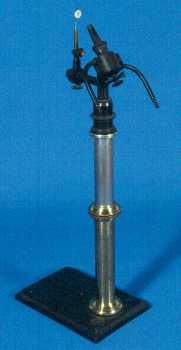The example at the left is at Denison University in Granville, Ohio, while the one at the right in in the Greenslade Collection. They were both made by A. Brüss of Hamburg, and are marked 1904.
|
The example at the left is at Denison University in Granville, Ohio, while the one at the right in in the Greenslade Collection. They were both made by A. Brüss of Hamburg, and are marked 1904. |
| This Davy or miner's lamp in the collection of Washington
and Jefferson College in Washington, Pennsylvania.
It is marked "John Mills/Newcastle on Tyne." The 1881 catalogue of James W. Queen of Philadelphia shows a very similar lamp priced at $4.00. The miner's safety lamp, invented by Humphry Davy in the first few years of the nineteenth century, had its open flame confined by the wire gauze surrounding it, and was consequently used in coal mines where flammable gases might exist. |
| Locatelli's lamp was used as a source for experiments on thermal
radiation. Thus, it was both a light and a heat source.
The lamp burns alcohol in the wick placed at the focal point of the polished copper reflector. There is no chimney, and the cylindrical tank holds the alcohol. The lamp at the left, from the Greenslade Collection, was sold by Max Kohl of Chemnitz at 14.50 marks about 1900. At the right is a lamp by an unknown maker in the Garland Collection of Classic Physics Apparatus at Vanderbilt University. |

|
The Zirconia Burner at the left produces an intensely bright
and white light. Jets of oxygen and either hydrogen or illuminating gas impinge
on the button at the top and are ignited.
This is related to the more familiar lime light, in which a block of solid lime is burned by the hot flame. I suspect that the zirconia button is longer lasting than the lime. This apparatus is in the apparatus collection of Dartmouth College. |
| When I first visited the collection of historic physics
apparatus at Dartmouth College in October 1979, Prof. Alan King told me that
this gas lamp was a Welsbach lamp.
A Welsbach burner operates by the combustion of a mixture of air and gas to heat a gas mantle to incandescence. Inside the Dartmouth lamp can be seen the mantle of ash, protected by the mica shade. It is thus a precursor of the familiar Coleman gasoline lantern, in which the pressurized gasoline is vaporized by passing it through a fine jet. |
| I found this light source in the apparatus collection at Dartmouth College. It appears to be a kerosene lamp in a portable holder than can either be hung up or placed on a flat surface. Its shape pleased me, and I added it to my collection of images. |
| This lime-light burner is in the Jack Judson Collection
at the Magic Lantern Museum in San Antonio, Texas. The connections for the
oxygen and acetylene supplies are projecting to the left on the lower side
of the base, and the combustion jet is pointing toward the block of calcium
carbonate.
The apparatus is designed to slip into a projector
and was made by T[homas] Hall of Boston. |
|
Below is an Argand Lamp from the Jack Judson Collection in
San Antonio, Texas. The writing on the chimney reads "Stork Brand/Fireproof/Made
in Denmark". This gas lamp was used as a standard in France in the latter
years of the nineteenth century. The burner, at the right, has twenty-two
orifices to ensure complete combustion.